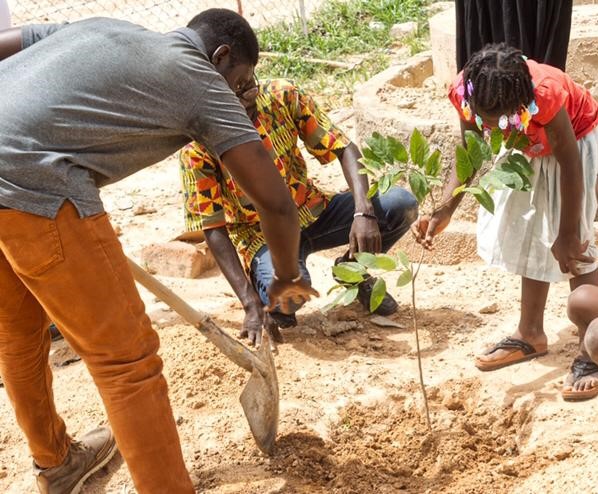
Time for Creation 2024
Saving the earth

The Time for Creation is the time of year when Christians around the world are invited to pray and reflect on ecology and the safeguarding of Creation. It is an ecumenical period dedicated to prayer and action for Creation. It takes place every year over 5 weeks, from 1 September to 4 October, the feast of Saint Francis of Assisi. During this period, communities from all over the world come together to reflect on the importance of saving the planet and take concrete action to conserve it.
El Hadj Salifou Ouédraogo, the baobab magician
Here is the story of El Hadj Salifou Ouédraogo, a man who made a difference. An experienced farmer from Burkina Faso, a wise and visionary man, who since 1968, braving fears and misunderstandings, has embarked on a bold and revolutionary project: planting baobabs.
Failure and disillusionment
El Hadj Salifou Ouédraogo dreams of becoming a sheik, a master of the Koran. A project he is unable to realise.
Back home in Titao (Loroum Province in the northern region of Burkina Faso), he decides to start growing mangoes. His experiment ends in bitter disappointment. All the mangoes rot and the project is a failure.
Resilience and perseverance
After this unfortunate experience, El Hadj Salifou Ouédraogo leaves his village and settles in a site assigned to him in Siguinonguin (north of Bobo Dioulasso). He decides to plant some baobabs to harvest the leaves and feed his family. From this simple family project comes an inspiration: why not turn it into a real crop? El Hadj Salifou Ouédraogo realises that planting baobabs can be a unique opportunity not only to improve the food and economic security of his community, but also to preserve his land. According to scientists, baobab trees have an exceptional lifespan of between 1,000 and 2,000 years.
However, the beginnings are laborious and difficult. The villagers make fun of him. Misunderstood, called crazy, many predict its death. According to tradition, whoever plants a baobab tree dies.
Undeterred, he continues to follow his inspiration. Not listening to those who foretold him doom, he goes in search of baobab seeds to create a nursery.
The baobab, a tree of many virtues
 The baobab is not only a majestic tree, it’s also a natural treasure. It is nicknamed the ‘tree of a thousand uses’ for its countless benefits. Its leaves, used as food and cooked in sauces, are rich in proteins and minerals: calcium, iron, potassium, magnesium, manganese, phosphorus and zinc. Its fruit, known as ‘monkey bread’, is rich in vitamins and prized for its nutritional value. A traditional remedy, the bark is used to combat a range of ailments and diseases. The tree is also able to store large quantities of water in its trunk, enabling it to survive in arid conditions. Thanks to its deep roots, the baobab can help stabilise the soil and prevent erosion.
The baobab is not only a majestic tree, it’s also a natural treasure. It is nicknamed the ‘tree of a thousand uses’ for its countless benefits. Its leaves, used as food and cooked in sauces, are rich in proteins and minerals: calcium, iron, potassium, magnesium, manganese, phosphorus and zinc. Its fruit, known as ‘monkey bread’, is rich in vitamins and prized for its nutritional value. A traditional remedy, the bark is used to combat a range of ailments and diseases. The tree is also able to store large quantities of water in its trunk, enabling it to survive in arid conditions. Thanks to its deep roots, the baobab can help stabilise the soil and prevent erosion.
A winning bet
Today, at over 80 years of age, El Hadj Salifou Ouédraogo has succeeded in his gamble. He has planted more than 35,000 baobab trees and farms nearly 14 hectares of baobab trees in Burkina Faso.
He supplies many people with seeds, sells baobab stalks and provides food and medicine to his community and the surrounding villagers.
56 years of activity, 56 years of symbiosis with his plants and his land, from the seeds he collects, sorts and plants. He has also been able to pass on his knowledge to his children, who have joined him in this activity.
A silent guardian of the earth
Although he did not become the sheikh of his dreams, old Salifou knows that he is doing useful work. His devotion to his trees is a truly sacred calling. By sowing, cultivating and harvesting, he maintains an intimate relationship with the earth. His crazy gamble of planting baobabs has transformed his living environment and is a real response to the fight against global warming.
A documentary film entitled ‘The man who plants baobabs’ tells the story of El Hadj Salifou Ouédraogo and his achievements. It can be viewed at this link : https://youtu.be/cv8keCMr0WU
Images
- Photo by Bernard Minani
- File:Baobab 04.jpg – Wikimedia Commons
- Photo gratuite de affiches, conservation de l’environnement, Sauver la terre (pexels.com)
